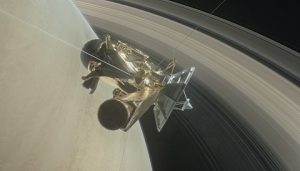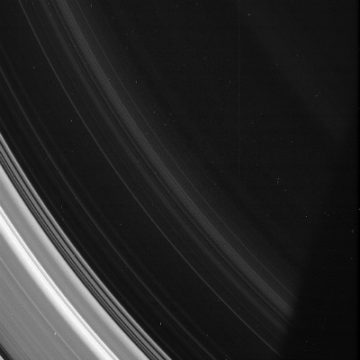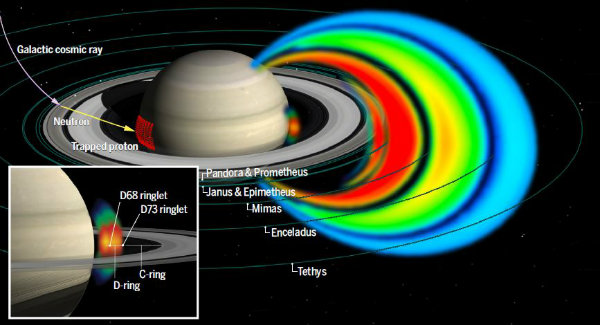Cassini gave an epic final show with a series of high-risk maneuvers to go where no space probe had gone before. Here are a few interesting things we learned from that finale.

After 13 years orbiting Saturn, the Cassini mission ended on September 15, 2017, with a dive into the planet’s atmosphere.
But during the final stage of operation, while the spacecraft was practically running on fumes, NASA engineers devised a series of daredevil maneuvers designed to probe previously uncharted territory. During its Grand Finale, Cassini passed several times between the planet’s rings and atmosphere, grazed the outer rims of the rings, and visited the high latitude areas where it observed the planet’s auroras.
It also orbited the planet more frequently, providing more regular observations of changing features such as the planet’s busy magnetosphere. “The Grand Finale orbits allowed us to also access unexplored time scales,” says Elias Roussos (Max Planck Institute for Solar System Research, Germany). “Such kinds of data lend themselves to discoveries, and I believe there are still many more of those to come in the future.”
In the October 5th Science, six new research papers detail what researchers learned over the past year thanks to Cassini’s final show. Here are a few takeaways.
1. The rings are made of a frozen soup of chemicals
Previous remote measurements had revealed long ago that Saturn’s rings are made mostly of water ice grains. However, the full recipe was a mystery. During its Grand Finale, Cassini collected and analyzed some of the grains that fall from the rings into the planet, in a phenomenon dubbed “ring rain.”
“We expected water vapor and grains, and we saw methane, molecular nitrogen, and carbon dioxide,” says Hunter Waite (Southwest Research Institute), first author of one of the new papers. Cassini also detected ammonia and organic compounds tied to tiny, nanogram-scale ice-water grains.
Researchers don’t know yet if this composition is representative of all the rings or just the innermost ones, which might have been polluted by interactions with the planet or by other passing bodies such as comets. Alternatively, the rings might be a reservoir from the original disk of gas and dust surrounding the Sun from which the planets formed. Or perhaps there are unknown processes that form and maintain the rings, feeding them with these chemicals.
2. More than rain, it’s a downpour.

NASA / JPL-Caltech / Space Science Institute
The amount of material falling from the rings into Saturn is much higher —at least 10 times more — than anticipated. Most of this material appears to come from the inner regions of the D ring, the one closest to the planet. As the rings spin around the planet, they hurl tons of grains of ice coated with the chemical mix described earlier. Astronomers calculated a precipitation of 10 tons of material per second. Over millions of years, this downpour could change the composition of Saturn’s equatorial atmosphere.
Researchers also observed that the grains appear to have a preferential source: the D68 ringlet, a brightened region of the D ring that might have been altered by a collision with a passing object such as a comet.
This has prompted astronomers to review their ideas about the ring’s longevity. “At the present rate of infall, the D ring, if not resupplied from the C ring, would disappear in a few million years,” says Waite. That means that at some point the rings might vanish, unless they are replenished by an unknown mechanism.
3. There is a radiation belt between the rings and the atmosphere
Most planets with a magnetic field, such as Earth, are surrounded by radiation belts that trap charged particles. In the case of Saturn, researchers already knew about radiation belts outside the rings. Scientists suspected there could be an additional radiation belt between the planet and the rings, but had never been able to detect it until now.
“We knew that there are processes that could deliver high energy particles near Saturn,” Roussos says. “But any charged particle that is injected between Saturn and its dense rings has to fight against impacts with the planet’s atmospheric molecules and with dust in Saturn’s D-ring which deplete its energy.”

observed during Cassini's Grand Finale.
MPS, JHU-APL
Nevertheless, Cassini detected a belt of charged protons just above the atmosphere. This new belt is split into two segments due to the presence of the D68 ringlet, which absorbs protons. However, there is another ringlet called D72, which doesn’t seem to influence the belt at all. “We did not consider these ringlets as important when we were building our radiation belt models several years back. Now we see how strong their influence is and how diverse they are,” says Roussos.
4. Like on Earth, auroras can produce radio emissions
During Cassini’s passes through Saturn’s magnetosphere, the probe measured radio emissions from particles that generate the auroras. Auroras on Saturn are in some ways similar to those on Earth: Charged particles travel along magnetic field lines and excite certain atoms. On Saturn, though, auroras emit ultraviolet light from excited hydrogen atoms, rather than from oxygen and nitrogen.
On Earth, the charged particles that create the auroras can power a different phenomenon when they are higher up in the atmosphere. At a certain altitude they encounter magnetized plasma. Auroral magnetic field lines trap the electrons, which then transmit their energy to radio waves.
Researchers have now shown that these radio emissions exist also on Saturn. They measured low frequency radio sources between 10 kHz and 20 kHz, generated a couple hundred thousand kilometers above the atmosphere. They also observed that these emissions change with time, revealing that the plasma density changes locally. “Why the plasma density varies so much with time is an open question so far,” says Laurent Lamy (Paris Observatory, France). “But this is interesting, to note that radio emissions provide a diagnostic of local plasma conditions.”
References:
M. K. Dougherty et al. “Saturn’s magnetic field revealed by the Cassini Grand Finale." Science. October 5, 2018.
E. Roussos et al. "A radiation belt of energetic protons located between Saturn and its rings." Science. October 5, 2018.
L. Lamy et al. "The low-frequency source of Saturn’s kilometric radiation." Science. October 5, 2018.
H.-W. Hsu et al. “In situ collection of dust grains falling from Saturn’s rings into its atmosphere." Science. October 5, 2018.
D. G. Mitchell et al. "Dust grains fall from Saturn’s D-ring into its equatorial upper atmosphere." Science. October 5, 2018.
J. H. Waite et al. "Chemical interactions between Saturn’s atmosphere and its rings." Science. October 5, 2018.
 0
0









Comments
You must be logged in to post a comment.